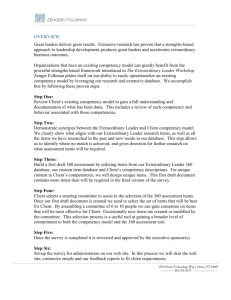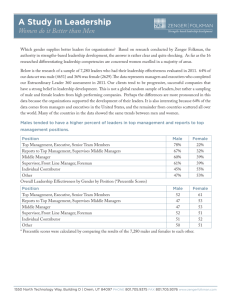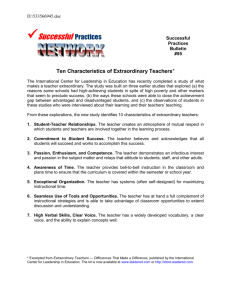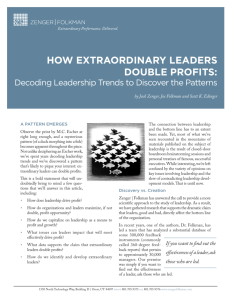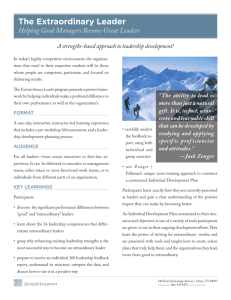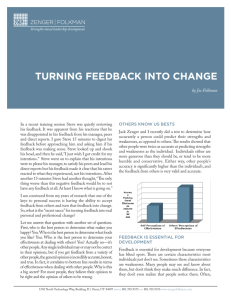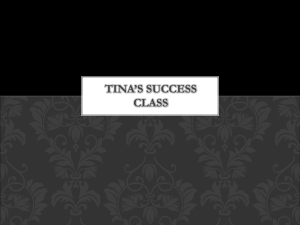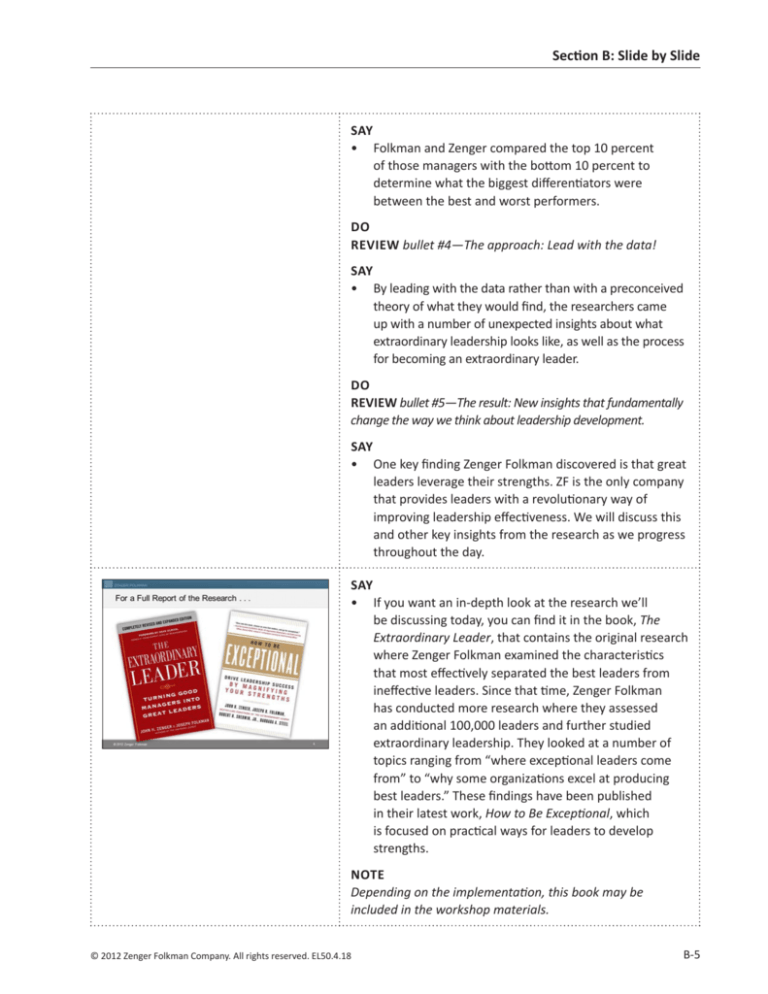
Section B: Slide by Slide
SAY
• Folkman and Zenger compared the top 10 percent
of those managers with the bottom 10 percent to
determine what the biggest differentiators were
between the best and worst performers.
DO
REVIEW bullet #4—The approach: Lead with the data!
SAY
• By leading with the data rather than with a preconceived
theory of what they would find, the researchers came
up with a number of unexpected insights about what
extraordinary leadership looks like, as well as the process
for becoming an extraordinary leader.
DO
REVIEW bullet #5—The result: New insights that fundamentally
change the way we think about leadership development.
SAY
• One key finding Zenger Folkman discovered is that great
leaders leverage their strengths. ZF is the only company
that provides leaders with a revolutionary way of
improving leadership effectiveness. We will discuss this
and other key insights from the research as we progress
throughout the day.
SAY
• If you want an in-depth look at the research we’ll
be discussing today, you can find it in the book, The
Extraordinary Leader, that contains the original research
where Zenger Folkman examined the characteristics
that most effectively separated the best leaders from
ineffective leaders. Since that time, Zenger Folkman
has conducted more research where they assessed
an additional 100,000 leaders and further studied
extraordinary leadership. They looked at a number of
topics ranging from “where exceptional leaders come
from” to “why some organizations excel at producing
best leaders.” These findings have been published
in their latest work, How to Be Exceptional, which
is focused on practical ways for leaders to develop
strengths.
NOTE
Depending on the implementation, this book may be
included in the workshop materials.
© 2012 Zenger Folkman Company. All rights reserved. EL50.4.18
B-5
Section B: Slide by Slide
TRANSITION
• Now let’s look at what the data show when it comes
to another key organizational metric: Employee
Commitment. You can see how managers were
separated into deciles, or groups of 10, according to their
assessment results. This is reproduced on page 1-4 in
your workbook.
SAY
• Here we’re seeing how leadership effectiveness
correlates with Employee Commitment. Employee
Commitment is measured through the Zenger Folkman
360-degree assessment items. Direct reports of leaders
are asked five questions such as “I rarely think about
quitting my job to go to another organization,” and “All
in all, I’m satisfied with this organization as a place to
work” to determine their overall level of commitment.
This data set represents over 30,000 leaders across a
multitude of businesses and industries. In fact, out of
hundreds of studies Zenger Folkman has conducted
on employee engagement, they’ve never not seen this
trend.
ASK
What trend do you notice regarding this chart? [The more
effective the leader, the more engaged and committed the
employee is to the organization.]
What difference will it make to your organization, if you
had highly engaged and committed employees? [Engaged
employees will be more productive, creative, and create a
better working environment.]
SAY
• We can probably agree that poor leaders create
dissatisfaction among their employees. This shouldn’t
come as a surprise to any of us.
ASK
How many of you have ever worked for a lousy leader?
What was that experience like? Contrast this experience
with what it’s like to work for a great leader. How would
you describe the difference in impact on you? [Briefly
process responses.]
© 2012 Zenger Folkman Company. All rights reserved. EL50.4.19
B-11
The Extraordinary Leader | Facilitator’s Guide
TRANSITION
• Good leaders have an impact on the business. They are making
contributions and their people show varying levels of commitment.
• One of the benefits of having committed employees is
that employees are more willing to do what it takes to
get the job done.
• Just to show that this benefit exists when we improve our
leadership effectiveness, we have one final study to show you.
SAY
• Zenger Folkman studied the same group of 30,000
leaders across various industries, and correlated their
overall effectiveness, as measured by their survey scores,
with a single item asked to the direct reports of those
leaders: “My work environment is a place where people
want to go the extra mile.” This graph reflects the direct
reports who Strongly Agreed with the statement.
ASK
What conclusion would you draw about this data?
[Being an average leader actually does not create a work
environment where most employees are willing to go the
extra mile; it takes being an extraordinary leader to create
this type of work environment.]
SAY
• In today’s work environment, employees are being asked to
do more and more with less. Being able to lead effectively so
employees go the extra mile has become an absolute necessity.
ASK each table group to DISCUSS the implications for
increasing leadership from “good” to “great.” Facilitate a quick
debrief to capture key themes from each table discussion.
Any observations or questions at this point?
DO—ACTIVITY
PROVIDE current information about your organization’s
employee engagement goals and other relevant information
about this priority. Explain the anticipated impact on the
business if the goals are met.
SAY
• One of the key findings of this research is that there’s no
limit to the number of great managers your organization
can have at any given time. And, as we continue to
improve leadership effectiveness, we’ll also improve
organizational results.
B-12
Module 1: Making a Difference
Section B: Slide by Slide
8:45 – 9:00: Richard Case Study
TRANSITION
• We’ve looked at the correlation between leader
effectiveness and organizational results on a macro
level. Now let’s explore this relationship further at
the individual leader level by reviewing a case study.
Please read the case study on page 1-5 and discuss the
questions at the end with others at your table. After
you’ve finished, we’ll talk about the case as a group.
DO—ACTIVITY
GIVE CLEAR INSTRUCTIONS for the case study. You want
everyone to READ it quickly to themselves, STUDY the
graph on page 1-5, and then THINK about the questions on
page 1-6.
DO
When more than half of the participants have turned to
page 1-6, get the group’s attention and ANNOUNCE that
you’d like them to discuss the questions briefly at their
tables. Tell them they’ll have five minutes to discuss.
ALLOW them five minutes; then CALL TIME.
SAY
• Now that you’ve read the case and talked about it at
your tables, let’s see what our consensus is on the
questions.
ASK
The first question asks, overall, how’s Richard doing? What
do you think? [Responses will probably be variations on,
“Richard’s doing okay,” or “Richard’s good but not great.”]
What do you think of the manager’s comments to “just
keep doing what you’re doing”? [Move quickly here. You
don’t want to descend into manager-bashing. All you need is
a quick comment that the manager isn’t providing much in
the way of coaching.]
If Richard implements this manager’s advice, what do
you see happening to future performance? [Probable
decline. Why? Because if you’re not improving, you’re falling
behind.]
© 2012 Zenger Folkman Company. All rights reserved. EL50.4.19
B-13
The Extraordinary Leader | Facilitator’s Guide
ASK
Final question. Put yourself in the shoes of Richard’s good
friend and confidant—not manager. Assume you’re at
lunch and Richard asks you for advice, after sharing with
you his feedback results. What would you say? [Take two
or three responses, again without evaluating.]
What would you suggest that Richard work on? [Discuss
responses. Some participants will suggest he work on his
strengths; others might suggest he work on weaknesses.]
Did anyone think Richard should work on his lower
scores—like Communicates Powerfully and Prolifically
or Builds Relationships? [Facilitate a brief discussion,
emphasizing how we’re conditioned to focus on the lowest
scores.]
NOTE: IMPORTANT POINT
If people give you the “right answers” that Richard should
be working on his strengths [e.g. Solves Problems and
Analyzes Issues, Drives for Results, Connects the Group to
the Outside World, etc.], you want to invite a conversation
that compares and contrasts the impact of Richard working
on a weakness versus a strength.
TRANSITION
• So far we’ve been looking at Richard’s profile where
his scores have been compared to the global average
ratings of leaders in Zenger Folkman’s database. When
a leader’s feedback is comparable to the average,
they think that aren’t doing so bad. Consequently,
they’re not very motivated to do anything dramatically
different.
ASK
In this slide, Richard is compared against the same standard
you will see in your feedback report—the 90th percentile.
Do you think Richard might perceive his leader effectiveness
differently when compared with 90th percentile leaders?
If so, why? [Most people will likely say this is precisely what
Richard needs to understand why he needs to raise his
effectiveness level in order to excel in his organization as a
leader.]
B-14
Module 1: Making a Difference
Section B: Slide by Slide
SAY
• In some ways, looking at feedback this way can be
somewhat discouraging. Most of us feel overwhelmed
by the idea of trying to be above the 90th percentile in
everything. That’s true. Few leaders can be in the 90th
percentile in everything. Fortunately, that’s not what
it takes to be an extraordinary leader. In fact, research
shows that only about a third of all leaders have one
or more competencies at the 90th percentile. We’ll talk
more about that later.
• What this type of feedback might accomplish is to keep
you from being complacent, or keep you from being
content with being good. When you look at your results
in comparison to great leaders instead of in comparison
to good leaders, it makes a difference in your motivation
level for trying to raise your level of effectiveness.
ASK
Does this change the advice you’d give Richard? [Facilitate
a discussion; typically participants will suggest that Richard
should work on some of his stronger competencies. If
they don’t point this out, you will want to suggest this,
mentioning that he is reasonably close to the 90th percentile
on some of the competencies. Perhaps there is value in
trying to push those strengths higher.]
What might happen if Richard decided to work on his
lower scores? What would his feedback look like if we
re-assessed him in a year? [He might improve his scores
slightly.]
SAY
• If Richard were to work on those competencies that
were below average by putting together a Development
Plan, he would likely bring them up to average over
time.
ASK
What would happen to the rest of his competencies? [They
might stay flat or even decline somewhat.]
TRANSITION
• So, if Richard were to work on his weaknesses, he might
improve slightly, but he might turn out to perform at an
average level overall. This probably won’t move Richard from
“good” to “great.” In our next section, we’ll really explore the
value in developing strengths versus weaknesses.
© 2012 Zenger Folkman Company. All rights reserved. EL50.4.19
B-15
The Extraordinary Leader | Facilitator’s Guide
9:15 – 9:17: Introduce the Module
TRANSITION
• Now we’re going to move on to the next section of the
workshop that focuses on the second insight from the
research.
• Insight #2 is good news for all of us: being extraordinary
doesn’t mean perfection. Steve Jobs, former CEO of
Apple Inc., leaves a legacy to be envied by most. Jobs
is thought to have been the “greatest executive of this
era.” He’s influenced the way people live not to mention
the computing, publishing, movies, music and mobile
telephone industries. However, his innovative marketing
approaches and ideas weren’t always respected or
admired. Several headlines from his toughest critics
include:
—— “Sorry Steve, Here’s Why Apple Stores Won’t Work,”
Business Week, 2001.
—— “The iPod will likely become a niche product,”
Harvard Business School professor.
• Despite these opinions, in 2011, Apple became the
world’s most valuable publicly traded company (in
August 2012 record share price hit $680). Steve
Jobs, needless to say, proved his critics wrong. His
creativity, innovation, and brilliance resulted in
numerous technological advances in both the 20th
and 21st centuries. While he was a visionary genius,
he was far from perfect. His leadership style was very
controversial. On the one hand, he has been described
as having been focused, inspirational, and charismatic.
He’s been credited for one of the greatest corporate
turnarounds in business history (when rehired at Apple
as interim CEO, he took Apple from near bankruptcy
to profitability in two years). But he has also been
described as being mercurial, demanding, and
tyrannical; even “downright mean.”
B-18
Module 2: Profound Strengths and Fatal Flaws
Section B: Slide by Slide
SAY
• Still, Steve Jobs made an extraordinary impact in
business and on society with several profound
leadership strengths.
• In this section, we’re going to talk about both Profound
Strengths and Fatal Flaws.
9:17 – 9:30: The Importance of Strengths
TRANSITION
• Being an extraordinary leader isn’t about perfection.
Most of us have to unlearn some lessons that have
been reinforced our whole lives in order to develop our
strengths to become extraordinary leaders.
ASK
How many of you ever brought home a less-than-perfect
report card? What got the most attention—your highest
grades or your lowest grades?
If you open a feedback report, where do your eyes go
first—the highest scores or the lowest categories?
ASK
How many of you look forward to your annual
performance review because you know your manager
will spend most of the meeting extolling your virtues?
[Make the point that managers are conditioned to focus
on weaknesses when conducting a performance review
process.]
Has anyone ever heard of Six Sigma? What does this (and
other quality programs) tend to emphasize? [Six Sigma
is a brilliant process, but a major tenet is based on the
idea of making things defect free. We’re never going to be
defect-free human beings, but we tend to transfer the same
mentality into leadership development processes.]
© 2012 Zenger Folkman Company. All rights reserved. EL50.4.18
B-19
The Extraordinary Leader | Facilitator’s Guide
10:10 – 10:12: Introduce the Module
TRANSITION
• Today we’re going to talk about the importance of
multi-rater feedback, and talk a little bit about the
model on which this assessment is based. We’ll also
give you a tool that will help you complete a specific,
in-depth analysis of your own feedback report.
10:12 – 10:20: Discuss the Leadership Competencies and Tent Model
DO
REFER to the agenda flipchart.
SAY
• We’ve discussed the first three insights. Now we’re on
insight #4.
• If you’ve ever tried to find your way around a strange
city without a good map or GPS, you know the
importance of Insight #4. In order to plan where you
want to go, it’s important to know where you are
now. Just as your organization tracks its performance
against competitors and leaders in other industries,
it’s important for you to know your effectiveness in
comparison to best leaders.
• The research on extraordinary leaders identified 16
competencies that are the most likely to differentiate
great leaders. These were discovered by comparing the
top 10 percent of the 20,000 leaders in the database
with the bottom 10 percent. Statistical analysis showed
that these 16 competencies were what differentiated
the best leaders from the worst.
• In the past, many organizations talked about
competencies as if they were completely independent
from each other. The research showed that
competencies are actually linked.
• To best understand the interrelationships amongst the
competencies, let’s take a look at the Leadership Tent
and how it is used metaphorically in the Extraordinary
Leader feedback process.
B-34
Module 3: Leadership Competencies
Section B: Slide by Slide
SAY
• In the slide, the leadership tent is depicted with five key
dimensions or “tent poles.” The competencies cluster
together to form the poles of the tent. The more poles
that have height, the greater the interior area within
the tent which is used metaphorically to describe the
degree of leadership effectiveness.
• When you receive your feedback reports, you’ll have an
opportunity to assess the “shape” of your leadership
tent. You can determine the shape by gauging the
height of each tent pole (five dimensions) and see how
close they are to the 90th percentile. The more poles
that have height, the greater the interior area within
the tent and that represents your perceived leadership
effectiveness.
SAY
• Best leaders often have competencies distributed
among several “poles” or dimensions. When you
receive your feedback reports, however, you’ll first
want to establish whether you have three competencies
at the 90th percentile. Any three Profound Strengths
(90th percentile competencies) means you are an
exceptional leader. If you find you don’t have three
Profound Strengths, this afternoon, you will complete
a Development Plan with specific actions to help
you build on your existing strengths to become
extraordinary. On the other hand, if you determine you
are at or above the 90th percentile in a competency we
recommend that you put your efforts into developing
another profound strength. Others are more likely to
notice a competency moving from the 75th to the 90th
percentile than they would try to move one from the
90th to the 99th. Again use the CPO logic to develop a
competency where you have passion and one that the
organization needs.
© 2012 Zenger Folkman Company. All rights reserved. EL50.4.18
B-35
The Extraordinary Leader | Facilitator’s Guide
SAY
• As you know, there are many competencies that
pertain to leadership effectiveness. Why didn’t business
acumen, for example, make the list of 16? Isn’t it
important? When Zenger Folkman conducted the
research, both best and ineffective leaders possessed
business acumen. Does that mean business acumen is
irrelevant when it comes to a leader’s role? Absolutely
not! As a competency, it just didn’t distinguish the best
leaders from the other leaders so it didn’t make the list
of 16.
• These are the competencies that differentiate
extraordinary leaders and they are shown here,
grouped according to the five tent poles. Because these
represent the 16 competencies that distinguish best
leaders, these are the ones you were measured against
in the 360 feedback assessment.
DO
ASK participants if they have any questions about the
competency model or tent metaphor.
10:20 – 10:25: Introduce the concept and importance of feedback
How many of you have received a multi-rater assessment
in the past? [Note the number of participants who have
received 360 feedback in the past. If most of the class
members are veterans of this process, move the discussion
quickly. If few of them are, slow it down and go into more
detail.]
NOTE
Some groups may have received their feedback reports
before the workshop. This works well for groups where most
people have participated in feedback processes in the past.
If this approach is used, have those individuals read a ZF
white paper, “Leadership Under the Microscope” or “Making
Yourself Indispensable” as preparation for interpreting their
feedback results focusing on their strengths. It is inadvisable
to distribute feedback reports in advance of the workshop
for those who are new to the multi-rater feedback process.
Please note: in either case, participants tend to focus on
the weaknesses without a context and explanation for the
strengths-building approach.
B-36
Module 3: Leadership Competencies
Section B: Slide by Slide
SAY
• Next is the “Written Comments” section. The written
comments will provide insights to the ratings you’ve
received, so they will make more sense if you look
at them after reviewing the data. The comments are
verbatim and haven’t been edited.
• Section B of the Written Comments asks respondents
to identify any potential Fatal Flaws you might have.
When raters want to provide constructive feedback to
the leader, this is the logical place to record it. However,
this doesn’t automatically mean the feedback provided
represents a Fatal Flaw. Sometimes the responses
here are worded more tentatively: “She sometimes
does this...” or “On occasion, it would be nice if...” Pay
attention to those comments that are worded more
directly, and any feedback themes that are identified
by multiple people. While the majority of leaders don’t
have any Fatal Flaws on which they need to work, you
don’t want to be in denial about potential derailers,
either.
NOTE
Please note that your natural tendency will be to guess who
said what. Please know that research has shown that your
success rate in correctly guessing will only be 50 percent.
That means you are as likely to be wrong as you are to be
right. You don’t have to agree with everything represented
in the feedback but you do have to accept that it is others’
reality. Only then can you take action.
SAY
• In the next three sections of the report, you’ll find
supplemental views of data previously presented in
earlier sections of the report. These charts provide
an alternate view of the data and can be useful while
interpreting your feedback results.
• This view is of the Leadership Tent. It represents an
alternate view of the data presented in Section 2 of the
report. From this angle, it’s easier to gauge the height
of each tent pole and determine the “shape” of your
overall tent.
© 2012 Zenger Folkman Company. All rights reserved. EL50.4.18
B-45
The Extraordinary Leader | Facilitator’s Guide
SAY
• The data in this section is the same as the data
presented in Section 3 of the report. It enables you to
have an alternate view regarding your overall degree of
effectiveness as compared to best leaders at both the
75th and 90th percentiles.
SAY
• Finally, the last section of the report provides you with
a summary of the “Differences in Perception” between
you and your raters.
• In the left column, the 16 Differentiating Competencies
are shown. The next column reveals your “Total”
score for each competency area. (Remember the
total score doesn’t include the Self score.) The “Self”
column represents the rating you gave yourself for each
competency. The “Gap Size” represents the difference
between the “Total” score and your “Self” score. The
last column is a graphical depiction of the “Gap Size.”
Any gap that is approximately “0.3” or greater in size
is considered statistically significant. Where there’s
green, your respondents rated you higher than you
rated yourself. Wherever you see red, you rated yourself
higher than your respondents.
B-46
Module 3: Leadership Competencies
Section B: Slide by Slide
10:45 – 11:45: Introduce the Feedback Analysis Exercise
SAY
• In a few minutes you’ll receive your feedback reports.
The best place to start will be to read through the report
from cover to cover to comprehend your results and
determine how you are being perceived by your rater
groups. You don’t need to spend all of your time here
because the Step-by-Step Feedback Analysis in your
workbooks will really help you sort through the data to
find the key themes.
• Take a look at pages 3-5 through 3-10 in your workbooks.
Go through this step-by-step process for analyzing
your feedback report. Take your time; go through the
questions. The outcome of this exercise should be a list of
strengths and any possible Fatal Flaws.
• Take about 45 minutes to work through these questions.
• One other point regarding your reports: they are
confidential and have not been accessed by anyone at
your organization nor the facilitation team. The tool is
strictly meant for developmental purposes only.
DO—ACTIVITY
NOTE: Provide the instructions for the feedback analysis
before distributing the feedback reports.
CHECK with participants to see if they need more time to
analyze their feedback. If they are still working diligently,
give them another 15 minutes. Adjust according to the pace
of the workshop and the timing of lunch plans. Additionally,
be available to answer questions and provide extensive
coaching to participants.
11:45 – 12:30: Lunch Break
© 2012 Zenger Folkman Company. All rights reserved. EL50.4.18
B-47
The Extraordinary Leader | Facilitator’s Guide
DO
HIGHLIGHT a few of the responses on their list.
SAY
• This flipchart lists the necessary elements for peak
performance. Let me ask you some follow-up questions
about your experiences.
ASK
First, a question for thought. How long ago was this
extraordinary experience you chose? A year? Five years?
[Allow a bit of silence for them to contemplate. Typically,
about one third of the class will have experienced their
extraordinary moment within the last year, one third within
two to five years, and one third more than five years ago.]
Next question: How active have you been in trying to
replicate the experience?
SAY
• Too often, we get busy doing our jobs and forget about
trying to “engineer” great on-the-job experiences for
ourselves and others. If our approach is to sit back and
wait for these peak experiences to find us, we can risk
having to wait a very long time.
ASK
During your peak performance experience, how would you
assess your productivity level? High or low? [High] High or
really high? [Really high]
What was your level of employee engagement like? High
or low? [High] High or really high? [Really high]
How was your overall satisfaction with work during that
time? Also really high? [Yes, really high]
SAY
• So, for the majority of us in the room, we loved our
work, were really productive, and were highly engaged.
That sounds like a good combination to try to replicate.
• Zenger Folkman studied what constitutes extraordinary
experiences over time and found that three elements
are consistently present. They seem to be universally
present when it comes to peak performance—
Competence, Passion, and Organizational Needs. And
your experience bears that out.
B-54
Module 4: Building on Your Strengths
Section B: Slide by Slide
DO
HIGHLIGHT their captured responses that correspond with
each of the three universal elements: Competence, Passion,
Organizational Needs. For some of the responses it may not
be obvious as to which element it represents. For example,
autonomy or freedom. Ask the question, “who gave this
to you?” Answer: the organization. Another example,
creativity. Ask, “who allowed you to exercise creativity?”
Answer: the organization. If a participant attaches the
example to a different element, for example, Competence,
please don’t get into a dispute. The main objective is to
help them see the connection to CPO; it’s okay if they see
a different connection. Finally, any element that seems
to fall outside of CPO can be categorized under “Work
Environment.”
1:20 – 1:30: CPO Model and Discussion
ASK
For the extraordinary moment experience you referenced
in the last discussion, by show of hands, how many of you
used your expertise? And/or learned a new skill?
Did you have an impact on the business or make a
difference?
Did you care about the work you performed? And did you
have fun in the process?
SAY
• Your responses to the questions demonstrate the three
elements that are crucial for extraordinary performance
to happen: your Competence (or skills and abilities);
your Passion (the things you care deeply about); your
Organization’s Needs. When all three are in alignment,
you find your leadership sweet spot. The factors in the
work environment also influence your ability to achieve
extraordinary moments. Some of you mentioned work
environment factors that contributed to your peak
performance experience (co-workers, rewards and
recognition, etc.).
• We must have Competence, Passion, and Organizational
Needs, at a minimum, for extraordinary moments to
occur.
© 2012 Zenger Folkman Company. All rights reserved. EL50.4.18
B-55
The Extraordinary Leader | Facilitator’s Guide
TRANSITION
• Having two out of the three lined up doesn’t cut it. In
fact, one way of diagnosing why you’re not having an
extraordinary experience is to look at what happens
when one of the elements is out of place.
ASK
Has anyone ever known someone in this situation?
Highly competent, passionate about what they do,
but completely disconnected from the direction of the
organization? [Wait for acknowledgment, nods, etc.]
Does that create peak performance? [Obviously not for the
organization.]
How does someone arrive at this point? [It may be that
they gradually drift into irrelevance. Or it may be that the
organization changes dramatically, and shifts away from the
person’s strengths and interests.]
PROVIDE several examples of someone who has a
“professional hobby.” [e.g., the computer programmer
who loves writing code—for something that isn’t important
to the organization; the financial analyst who can create
brilliant spreadsheets that aren’t useful to others, etc. Make
sure to differentiate “professional hobbies” from “hobby
hobbies.” Professional hobbies, which are ones performed
at work, look legitimate on the surface. This type of hobby
is the one being defined in Variation #1 of the CPO model. A
true hobby, on the other hand, might be golfing or painting.
Rarely can someone parlay these into meaningful work
activities and is not intended to be included in the definition
of “professional hobby.”]
Of the three circles, which do you think changes the most
dramatically and the most often? [Organizational Needs.]
SAY
• Right. So part of creating extraordinary experiences for
yourself is to pay close attention to your organization’s
needs as they develop so that you’ll be in a position to
capitalize on them.
B-56
Module 4: Building on Your Strengths
Section B: Slide by Slide
ASK
How about this variation—you love what you do, the
organization desperately needs you to do it, but you have
no earthly idea how to do it? Anyone ever been there?
[Wait for acknowledgment.]
SAY
• We call this being a “novice” or “rookie.”
ASK
Is it OK to be a novice? When? [When you are new in a role.]
SAY
• In the short term, it’s not necessarily a problem. We call
it a learning curve.
ASK
But over time, ideally what should happen to one’s
competence? [It develops.]
SAY
• That’s right. One’s competence should develop and it
would constitute a leadership sweet spot that we’ll talk
about further in a few minutes.
© 2012 Zenger Folkman Company. All rights reserved. EL50.4.18
B-57
The Extraordinary Leader | Facilitator’s Guide
SAY
• Here’s an interesting one—fully competent, aligned
with the organization, but utterly lacking in passion!
You’ve lost interest in what you’re doing.
ASK
Have any of you found yourselves here? [Acknowledgment]
How do you think it happens? [It may just happen because
you do the same thing in the same way for too long. Or it
might be because you get overloaded and burn out. Or it
may be that the organization changes dramatically and you
don’t want to invest emotionally in a new situation.]
SAY
• This is actually the misalignment that occurs most often
in today’s organizations. It happens to almost everyone at
some point. And for a while, you can put up with it.
ASK
What’s the productivity level of the person who’s job feels
like a chore to them? [Really low productivity.]
SAY
• So this is not an ideal situation for the person or the
organization.
SAY
• So one of the ways to increase the likelihood of
becoming an extraordinary leader is to pay attention
to all three elements. Seek opportunities where these
three elements can potentially intersect as a result
thereby producing that “wow” factor. Too often, we sit
back and wait for opportunities to surface and magically
align. We could be waiting a long time for this to
happen.
ASK
Which of the three elements—competence, passion or
organizational needs—most often gets left out of the
conversation when we’re doing performance planning or
goal setting? [Passions]
SAY
• We often talk about our competence and our deliverables,
and maybe even future job roles that we’re being
considered for. But we rarely mention our interests—the
part that engages our hearts, not just our skills. It’s a huge
missed opportunity.
B-58
Module 4: Building on Your Strengths
The Extraordinary Leader | Facilitator’s Guide
SAY
• As Zenger Folkman researched extraordinary leaders,
they noticed some interesting trends in the data. There
were interactions between some of the competencies.
They found that leaders who possessed certain pairs
or combinations of competencies ended up being far
more likely to be extraordinary. All of the Differentiating
Competencies are good to have in and of themselves,
but for those leaders who possessed certain
combinations, they demonstrated greater leadership
capability.
SAY
• One interesting pair of competencies is this one: Builds
Relationships and Drives for Results. On the surface,
these two competencies may seem to be independent
of each other. That isn’t the case, however. The data
on Builds Relationships and Drives for Results were
startling for the researchers. The researchers queried
their database to identify leaders who were strong in
Building Relationships, but less strong at Driving for
Results. For this particular analysis, they didn’t worry
about other skills the leaders might have had. They
were interested only in the interaction between these
two competencies.
NOTE
• “Strong” in this case meant 75th percentile or above.
The researchers relaxed the standard a bit from the
usual 90th percentile, to emphasize the power of the
combination of strengths rather than a single towering
strength.
B-70
Module 5: Leadership Cross-Training
Section B: Slide by Slide
NOTE (CONTINUED)
• The “Builds Relationships” competency used in the
illustration is not a direct companion to “Drives for
Results.” Three behaviors make up Relationship
Building: Integrity and Trust, Effective Feedback and
Development and Provides Rewards and Recognition.
Because each of these are companions and isn’t one of
the core 16 competencies, it confuses participants to
use them in the illustration, “Powerful Combinations.”
So the competency, “Builds Relationships” is used to
represent the three companions for simplicity until the
concept of companion behaviors is formally introduced
later in the module. Please avoid explaining the
companion behavior methodology prematurely and
why Relationship Building is used instead unless directly
asked.
• Also note, the research slides for the combination
of “Technical and Professional Expertise/Builds
Relationships” have been included as hidden slides in
the PowerPoint deck. The illustration of this combination
will resonate with certain audiences, e.g. engineers.
Use discretion as to which example to use with the
audience; please do not use both illustrations in the
same presentation. Whichever illustration you use,
participants will be able to record it along with the
research data in their participant manuals on page 5-3.
ASK
How many of these leaders—strong in building
relationships, but not as strong in terms of results—would
you expect to make it into the extraordinary category—
being in the top 10 percent of leaders overall? [Wait for
responses and encourage guesses. If someone asks, remind
them that the extraordinary leaders were those who scored
in the top 10 percent of all leaders, overall.]
DO
After people have made their guesses, CLICK on
the animation to reveal the probability of being an
extraordinary leader: 12%.
SAY
• Then they looked at the opposite combination: strong
Drives for Results without strong Relationship Building
skills.
© 2012 Zenger Folkman Company. All rights reserved. EL50.4.18
B-71
The Extraordinary Leader | Facilitator’s Guide
ASK
How many of these leaders—strong on results, not so
strong in their relationship building skills—do you think
make it into the extraordinary category? Fewer or more
than the previous combination? [Wait for responses.]
DO
After people have made their guesses, CLICK on
the animation to reveal the probability of being an
extraordinary leader: 14%.
SAY
• Finally, they searched the database to find all those who
were strong in both areas. It seems logical that 26 percent
of the leaders who were strong in both their ability to “Build
Relationships” and “Drive for Results” would be in the
“extraordinary” category—but that’s not what they found.
DO
BUILD the animation to reveal the 72% build.
SAY
• This finding got their attention, to say the least. More
than two-thirds of those leaders who possessed
this combination of skills were in the extraordinary
category! They began to wonder if there were other
combinations of competencies that had the same
multiplier effect.
• They began to search for ways to help elevate strengths
in each of the 16 competencies. Were there ways to
unlock the secret to help leaders move from good to
great in these areas?
• This led Zenger Folkman to a slightly different analysis
of combinations. For every one of the 16 Differentiating
Competencies, the researchers discovered that there
were numerous behaviors that had a unique relationship
to the main competency. Someone who got a high score
on the competency got a high score on several other
behaviors. Conversely, someone who got a low score on the
competency got a low score on these same other behaviors.
It was as if the behaviors were velcroed together.
• Each of the 16 Differentiating Competencies had
between five and 12 statistically significant companion
behaviors, or Competency Companions, that seemed to
be connected with the main competency.
B-72
Module 5: Leadership Cross-Training
The Extraordinary Leader | Facilitator’s Guide
TRANSITION
• We have now come to the last session of the program.
In this module you’ll engage in a final activity. We’ll then
conclude the workshop with some important next steps
for you to implement with your manager and others
when you return to your office.
• We gain great benefits when we involve others in
our development process. In fact that leads us to
our final insight, “The more people you involve in
your development, the greater the likelihood of
improvement.”
SAY
• The researchers discovered that the more people you
involve in your development, the greater the likelihood
of improvement. Let’s look at the ways you’ve already
involved people in your personal process:
—— You’ve invited others to share their perceptions of
your leadership effectiveness using the 360 process.
—— You’ve shared your reactions with each other in this
workshop.
—— You’ve just engaged each other in brainstorming
ideas for practicing your competency or companion
behaviors.
—— Let’s now provide you with one more opportunity
to collaborate with a partner. In this activity
you’ll coach and you’ll receive coaching on your
Development Plan.
B-86
Module 6: Peer Coaching & Workshop Summary
Section B: Slide by Slide
SAY
• In addition to closing the loop, you’ll want to spend
more time reviewing your feedback report and refining
your Development Plan.
• When you’ve upgraded your plan and feel that you’re
ready, schedule an appointment and hold a discussion
about your plan with your manager.
• To help you keep track of the follow-up items from this
workshop, you’ll find an action checklist on page 6-4.
Take a moment to fill in the deadlines, or transfer the
tasks and deadlines to your organizer.
• Before we wrap up the workshop, I’d love to hear what key
insights and take-aways you have received from this workshop.
DO
INSTRUCT participants to go around the room and share an
insight, take-away, or action they plan to take.
Alternatively, INSTRUCT participants to share their insights
at table-tops. (This will work better if the group is large and
time remaining is limited.)
REINFORCE their commitment to executing their plans
will lead to raising their leadership effectiveness and drive
positive organization results. Tell a story or give an example
that further illustrates this important point.
AFFIRM the take-aways that participants are stating in
their closing comments.
TRANSITION
• We’ve got one final thought for you from—Fred Fiedler
and Martin Chemers, authors of the book, Improving
Leadership Effectiveness:
—— Fred Fiedler, PhD was a professor at several
universities in the US. He is an author and widely
respected for having published over 200 articles
and books. He contributed to the disciplines
of psychology, management and leadership.
(Encyclopedia of History of American Management)
—— Martin Chemers, PhD was a research associate to Dr.
Fiedler at the University of Illinois where he received
his PhD and later became a professor. Chemers and
Fiedler were co-authors. Chemers has performed
extensive research in the leadership field, is highly
regarded and has also published numerous books.
© 2012 Zenger Folkman Company. All rights reserved. EL50.4.18
B-97
The Extraordinary Leader | Facilitator’s Guide
SAY
• Fiedler and Chemers have it right. “The quality
of leadership, more than any other single factor,
determines the success or failure of an organization.”
If we’re willing to focus on our strengths, play to our
passions, and practice a lot, extraordinary leadership
is within reach for all of us—and that is an extremely
encouraging thought.
DO
THANK participants for their involvement in the workshop
and ASK them to complete the evaluation on page 6-7.
NOTE
ZF Facilitators should collect the evaluations and submit
them to Zenger Folkman.
B-98
Module 6: Peer Coaching & Workshop Summary
Extraordinary Leader Development Plan
1. My Strengths (Which Differentiating Competencies do I demonstrate closest to the 90th percentile?)
2. Potential Fatal Flaws (Do I have a serious deficiency in any of the Differentiating Competencies?)
3. Passion and Organizational Needs (How will I make a unique and lasting contribution?)
4. Competencies to Strengthen (Which 3 - 5 Differentiating Competencies represent priorities for development?)
© 2012 Zenger Folkman. All rights reserved. EL50.39.4
5. Developmental Priority (List your highest priority competency.)
6. Competency Companions (Which Competency Companions make the most sense to work on? Why?)
7. Ideas for Development (How will I practice new skills and behaviors to increase my leadership effectiveness?)
Brainstorm and record the ideas you receive from your colleagues:
8. Turning Ideas Into Action (Which ideas will I implement?)
My development goal(s):
Specific actions I will take:
Date by which I will complete the goal:
Ways to keep my focus on this goal:
Potential barriers/obstacles:
How to overcome them:
Support/resources I may need:
Extraordinary Leader Development Plan

